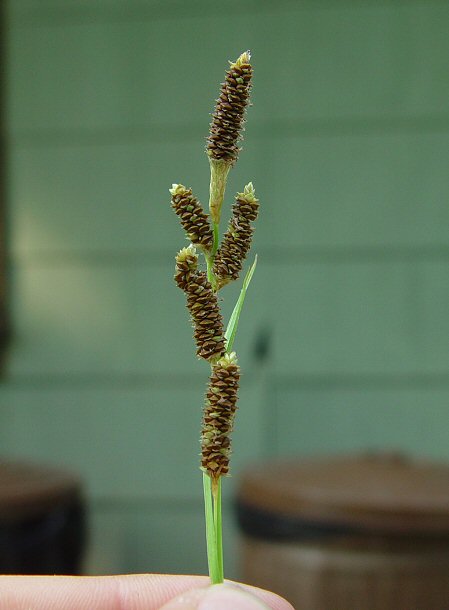Carex shortiana Dewey
Short's Sedge

Native
CC = 4
CW = -3
MOC = 84
© DETenaglia
Carex shortiana DeweyShort's Sedge | |
 |
Native CC = 4 CW = -3 MOC = 84 |
© DETenaglia |
|
Family - Cyperaceae, Carex section Shortianae Habit - Monoecious sedge with rhizomes absent or poorly developed, forming dense clumps. Stems - Flowering stems 40-80 cm long, erect, strongly trigonous, glabrous, roughened on the angles, brown at the base. Vegetative stems present (actually false stems composed nearly entirely of a series of overlapping leaf sheaths), short, leafy. Leaves - Basal and on the lower half of the stems, mostly longer than the stems, glabrous, all with well-developed blades. Leaf blades 10-40 cm long, 4-8 mm wide, the margins and midrib minutely roughened or toothed, flat, light green. Leaf sheaths with the tip extended past the insertion point of the leaf and concave, the ligule longer than wide and U-or V-shaped, the ventral side usually thin, papery, sometimes somewhat cross-wrinkled, and light brown to light red tinged, the dorsal side greenish white, the lowermost sheath bases brown.
Inflorescence - Spikes 4-6 per stem, the lowermost bracts leaflike, often longer than the inflorescence, lacking a sheath or nearly so, the uppermost bract short and hairlike. Terminal spike pistillate toward the tip with 20-60 perigynia spreading at a right angle to the axis, staminate in the basal 1/4, 10-35 mm long, 4-5 mm wide, linear, sessile or with a short, roughened stalk. Lateral spikes 3-5, loosely spaced near the tip of the axis, the uppermost sessile or short-stalked, the lowermost usually long-stalked, ascending, similar to the terminal spike, but all pistillate or with a few inconspicuous, staminate flowers at the base.
Perigynia - Staminate scales 3-4 mm long, oblong-obovate, the tip rounded to bluntly pointed, sometimes short-awned, reddish brown to straw-colored, with a green midrib and lighter margins. Pistillate scales 1.5-3.2 mm long, ovate, rounded to sharply pointed and often short-awned at the tip, reddish brown to straw-colored, with a green midrib and lighter margins. Perigynia 1.8-3.0 mm long, about as long as wide, bluntly trigonous and somewhat flattened in cross-section, obovate in outline, rounded and very short-beaked at the tip, narrowed to a short, stalklike base, the surface with 2 lateral ribs, otherwise nerveless, sometimes somewhat cross-wrinkled, glabrous, the surface smooth and not pebbled, olive green to dark reddish brown. Styles withering during fruit development, jointed to the main body of the fruit, which is short-beaked at maturity. Stigmas 3. Fruits 1.6-1.9 mm long, elliptic to obovate in outline, sharply trigonous with concave sides, brown.
Flowering - May - July. Habitat - Bottomland prairies, moist upland prairies, swamps, bottomland and mesic forests, pond margins, marshes, fens, roadside ditches, railroads. Origin - Native to the U.S. Lookalikes - None close. Other info. - This dark-fruited species is one of the easier Carex species to identify in Missouri. The fruits turn their characteristic chocolate color fairly early and make the plant very noticeable. The plant can be found throughout most of state but is less common in the central Ozark region and in the northwest corner of the state. From Missouri it ranges eastward in a band, present but uncommon as far east as Pennsylvania and Virginia. Photographs taken in the Ozark Scenic Riverways, Shannon County, MO., 6-17-03 (DETenaglia); also along the Katy Trail near Dutzow, Warren County, MO, 6-7-2020 (SRTurner). |